Application of the Hidden Markov Bayesian Classifier and Propagation Concept for Probabilistic Assessment of Meteorological and Hydrological Droughts in South Korea
Abstract
1. Introduction
2. Research Area and Data
3. Materials and Methods
3.1. Calculation of Standardized Drought Indices
3.2. Estimation of Propagation Probability
3.3. Markov Bayesian Classifier (MBC)
4. Results and Discussion
4.1. Relationship between SPI and SRI
4.2. Propagation Probability of Drought Classes
4.3. Assessment of Drought Classes
4.4. Performance Evaluation of the MBC
5. Conclusions
Author Contributions
Funding
Acknowledgments
Conflicts of Interest
References
- Mishra, A.K.; Singh, V.P. A review of drought concepts. J. Hydrol. 2010, 391, 202–216. [Google Scholar] [CrossRef]
- Vicente-Serrano, S.M.; López-Moreno, J.I.; Beguería, S.; Lorenzo-Lacruz, J.; Azorin-Molina, C.; Morán-Tejeda, E. Accurate computation of a streamflow drought index. J. Hydrol. Eng. 2011, 17, 318–332. [Google Scholar] [CrossRef]
- Wang, Z.; Li, J.; Lai, C.; Zeng, Z.; Zhong, R.; Chen, X.; Zhou, X.; Wang, M. Does drought in China show a significant decreasing trend from 1961 to 2009? Sci. Total Environ. 2017, 579, 314–324. [Google Scholar] [CrossRef] [PubMed]
- Wilhite, D.A.; Glantz, M.H. Understanding the drought phenomenon: The role of definitions. Water Int. 1985, 10, 111–120. [Google Scholar] [CrossRef]
- Wu, J.; Chen, X.; Yao, H.; Gao, L.; Chen, Y.; Liu, M. Non-linear relationship of hydrological drought responding to meteorological drought and impact of a large reservoir. J. Hydrol. 2017, 551, 495–507. [Google Scholar] [CrossRef]
- Botterill, L.C.; Fisher, M. Beyond Drought: People, Policy and Perspectives; CSIRO PUBLISHING: Clayton, Australia, 2003. [Google Scholar]
- Shukla, S.; Wood, A.W. Use of a standardized runoff index for characterizing hydrologic drought. Geophys. Res. Lett. 2008, 35. [Google Scholar] [CrossRef]
- Hollinger, S.; Isard, S.; Welford, M. A vew soil moisture drought index for predicting crop yields. In Proceedings of the Preprints, Eighth Conference on Applied Climatology, American Meteorological Society, Anaheim, CA, USA, 17–22 January 1993; Volume 17, pp. 187–190. [Google Scholar]
- Meyer, S.; Hubbard, K. Extending the crop-specific drought index to soybean. In Proceedings of the Preprints, Ninth Conference on Applied Climatology, Dallas, TX, USA, 15–20 January 1995; American Meteor Society: Anaheim, CA, USA, 1995; pp. 258–259. [Google Scholar]
- Palmer, W.C. Keeping track of crop moisture conditions, nationwide: The new crop moisture index. J. Weather. 1968, 21, 156–161. [Google Scholar] [CrossRef]
- Alizadeh, M.R.; Nikoo, M.R.J. A fusion-based methodology for meteorological drought estimation using remote sensing data. Remote Sens. Environ. 2018, 211, 229–247. [Google Scholar] [CrossRef]
- Feng, P.; Wang, B.; Li Liu, D.; Yu, Q. Machine learning-based integration of remotely-sensed drought factors can improve the estimation of agricultural drought in South-Eastern Australia. J. Agric. Syst. 2019, 173, 303–316. [Google Scholar] [CrossRef]
- Kędzior, M.; Zawadzki, J. SMOS data as a source of the agricultural drought information: Case study of the Vistula catchment, Poland. J. Geoderma 2017, 306, 167–182. [Google Scholar] [CrossRef]
- Strnad, F.; Moravec, V.; Markonis, Y.; Máca, P.; Masner, J.; Stočes, M.; Hanel, M. An index-flood statistical model for hydrological drought assessment. Water 2020, 12, 1213. [Google Scholar] [CrossRef]
- Yu, J.; Choi, S.-J.; Kwon, H.-H.; Kim, T.-W. Assessment of regional drought risk under climate change using bivariate frequency analysis. Stoch. Environ. Res. Risk Assess. 2018, 32, 3439–3453. [Google Scholar] [CrossRef]
- Nguyen-Huy, T.; Deo, R.C.; Mushtaq, S.; Kath, J.; Khan, S. Copula statistical models for analyzing stochastic dependencies of systemic drought risk and potential adaptation strategies. Stoch. Environ. Res. Risk Assess. 2019, 33, 1–21. [Google Scholar] [CrossRef]
- Santos, C.A.G.; Neto, R.M.B.; da Silva, R.M.; dos Santos, D.C. Innovative approach for geospatial drought severity classification: A case study of Paraíba State, Brazil. Stoch. Environ. Res. Risk Assess. 2019, 33, 545–562. [Google Scholar] [CrossRef]
- Banik, P.; Mandal, A.; Rahman, M.S. Markov chain analysis of weekly rainfall data in determining drought-proneness. Discret. Dyn. Nat. Soc. 2002, 7, 231–239. [Google Scholar] [CrossRef]
- Madadgar, S.; Moradkhani, H. Spatio-temporal drought forecasting within Bayesian networks. J. Hydrol. 2014, 512, 134–146. [Google Scholar] [CrossRef]
- Shin, J.Y.; Ajmal, M.; Yoo, J.; Kim, T.-W. A Bayesian network-based probabilistic framework for drought forecasting and outlook. Adv. Meteorol. 2016. [Google Scholar] [CrossRef]
- Chen, S.; Muhammad, W.; Lee, J.-H.; Kim, T.-W. Assessment of probabilistic multi-index drought using a dynamic naive Bayesian classifier. Water Resour. Manag. 2018, 32, 4359–4374. [Google Scholar] [CrossRef]
- Ropero, R.F.; Nicholson, A.E.; Aguilera, P.A.; Rumí, R. Learning and inference methodologies for hybrid dynamic Bayesian betworks: A case study for a water reservoir system in Andalusia, Spain. Stoch. Environ. Res. Risk Assess. 2018, 32, 3117–3135. [Google Scholar] [CrossRef]
- Van Loon, A.; Van Huijgevoort, M.; Van Lanen, H. Evaluation of drought propagation in an ensemble mean of large-scale hydrological models. Hydrol. Earth Syst. Sci. 2012, 16, 4057–4078. [Google Scholar] [CrossRef]
- Niu, J.; Chen, J.; Sun, L. Exploration of drought evolution using numerical simulations over the Xijiang (West River) basin in South China. J. Hydrol. 2015, 526, 68–77. [Google Scholar] [CrossRef]
- Wen, L.; Rogers, K.; Ling, J.; Saintilan, N. The impacts of river regulation and water diversion on the hydrological drought characteristics in the Lower Murrumbidgee River, Australia. J. Hydrol. 2011, 405, 382–391. [Google Scholar] [CrossRef]
- Al-Faraj, F.A.; Scholz, M. Assessment of temporal hydrologic anomalies coupled with drought impact for a transboundary river flow regime: The Diyala watershed case study. J. Hydrol. 2014, 517, 64–73. [Google Scholar] [CrossRef]
- Huang, Q.; Sun, Z.; Opp, C.; Lotz, T.; Jiang, J.; Lai, X. Hydrological drought at Dongting Lake: Its detection, characterization, and challenges associated with Three Gorges Dam in Central Yangtze, China. Water Resour. Manag. 2014, 28, 5377–5388. [Google Scholar] [CrossRef]
- Zhang, B.; He, C.; Burnham, M.; Zhang, L. Evaluating the coupling effects of climate aridity and vegetation restoration on soil erosion over the Loess Plateau in China. Sci. Total Environ. 2016, 539, 436–449. [Google Scholar] [CrossRef] [PubMed]
- Trajković, S.; Gocić, M.; Misic, D.; Milanovic, M. Spatio-temporal distribution of hydrological and meteorological droughts in the South Morava Basin. In Natural Risk Management and Engineering; Springer: Berlin/Heidelberg, Germany, 2020; pp. 225–242. [Google Scholar] [CrossRef]
- Jesus, E.T.d.; Amorim, J.d.S.; Junqueira, R.; Viola, M.R.; Mello, C.R. Meteorological and hydrological drought from 1987 to 2017 in Doce River Basin, Southeastern Brazil. Braz. J. Water Resour. 2020, 25. [Google Scholar] [CrossRef]
- Zhao, C.; Brissette, F.; Chen, J.; Martel, J.-L. Frequency change of future extreme summer meteorological and hydrological droughts over North America. J. Hydrol. 2020, 584, 124316. [Google Scholar] [CrossRef]
- Huang, S.; Li, P.; Huang, Q.; Leng, G.; Hou, B.; Ma, L. The propagation from meteorological to hydrological drought and its potential influence factors. J. Hydrol. 2017, 547, 184–195. [Google Scholar] [CrossRef]
- Liu, L.; Hong, Y.; Bednarczyk, C.N.; Yong, B.; Shafer, M.A.; Riley, R.; Hocker, J.E. Hydro-climatological drought analyses and projections using meteorological and hydrological drought indices: A case study in Blue River Basin, Oklahoma. Water Resour. Manag. 2012, 26, 2761–2779. [Google Scholar] [CrossRef]
- Zhao, L.; Lyu, A.; Wu, J.; Hayes, M.; Tang, Z.; He, B.; Liu, J.; Liu, M. Impact of meteorological drought on streamflow drought in Jinghe River Basin of China. Chin. Geogr. Sci. 2014, 24, 694–705. [Google Scholar] [CrossRef]
- Wu, J.; Chen, X.; Gao, L.; Yao, H.; Chen, Y.; Liu, M. Response of hydrological drought to meteorological drought under the influence of large reservoir. Adv. Meteorol. 2016. [Google Scholar] [CrossRef]
- Shin, J.Y.; Chen, S.; Lee, J.-H.; Kim, T.-W. Investigation of drought propagation in South Korea using drought index and conditional probability. Terr. Atmos. Ocean. Sci. 2018, 29. [Google Scholar] [CrossRef]
- Sattar, M.N.; Kim, T.-W. Probabilistic characteristics of lag time between meteorological and hydrological droughts using a Bayesian model. Terr. Atmos. Ocean. Sci. 2018, 29, 1–12. [Google Scholar] [CrossRef]
- Sattar, M.N.; Kim, J.E.; Lee, J.H.; Kim, T.W. Probabilistic analysis of drought propagation over the Han River Basin under climate change. J. Korean Soc. Civil. Eng. 2019, 39, 155–163. [Google Scholar] [CrossRef]
- Jehanzaib, M.; Sattar, M.N.; Lee, J.H.; Kim, T.W. Investigating effect of climate change on drought propagation from meteorological to hydrological drought using multi-model ensemble projections. Stoch. Environ. Res. Risk Assess. 2020, 34, 7–21. [Google Scholar] [CrossRef]
- Kim, C.J.; Park, M.J.; Lee, J.H. Analysis of climate change impacts on the spatial and frequency patterns of drought using a potential drought hazard mapping approach. Int. J. Clim. 2014, 34, 61–80. [Google Scholar] [CrossRef]
- Ahn, S.R.; Kim, S.J. Assessment of integrated watershed health based on the natural enviornment, hydrology, water quality, and aquatic ecology. Hydrol. Earth Syst. Sci. 2017, 21, 5583–5602. [Google Scholar] [CrossRef]
- Yoon, S.K.; Kim, J.S.; Lee, J.H.; Moon, Y.I. Hydrometeorological variability in the Korean Han River Basin and its sub-watersheds during different El Niño phases. Stoch. Environ. Res. Risk Assess. 2013, 27, 1465–1477. [Google Scholar] [CrossRef]
- Paik, K.; Kim, J.H.; Kim, H.S.; Lee, D.R. A conceptual rainfall-runoff model considering seasonal variation. Hydrol. Process. Int. J. 2005, 19, 3837–3850. [Google Scholar] [CrossRef]
- Song, J.H.; Her, Y.; Suh, K.; Kang, M.-S.; Kim, H. Regionalization of a rainfall-runoff model: Limitations and potentials. Water 2019, 11, 2257. [Google Scholar] [CrossRef]
- Jaiswal, R.; Ali, S.; Bharti, B. Comparative evaluation of conceptual and physical rainfall–runoff models. J. Appl. Water Sci. 2020, 10, 1–14. [Google Scholar] [CrossRef]
- McKee, T.B.; Doesken, N.J.; Kleist, J. The relationship of drought frequency and duration to time scales. In Proceedings of the 8th Conference on Applied Climatology, Anaheim, CA, USA, 17–22 January 1993; American Meteorological Society: Boston, MA, USA, 1993; pp. 179–183. [Google Scholar]
- Sattar, M.N.; Lee, J.Y.; Shin, J.Y.; Kim, T.W. Probabilistic characteristics of drought propagation from meteorological to hydrological drought in South Korea. Water Resour. Manag. 2019, 33, 2439–2452. [Google Scholar] [CrossRef]
- AghaKouchak, A.; Farahmand, A.; Melton, F.; Teixeira, J.; Anderson, M.; Wardlow, B.D.; Hain, C. Remote sensing of drought: Progress, challenges and opportunities. Rev. Geophys. 2015, 53, 452–480. [Google Scholar] [CrossRef]
- Maeng, S.; Azam, M.; Kim, H.; Hwang, J. Analysis of changes in spatio-temporal patterns of drought across South Korea. Water 2017, 9, 679. [Google Scholar] [CrossRef]
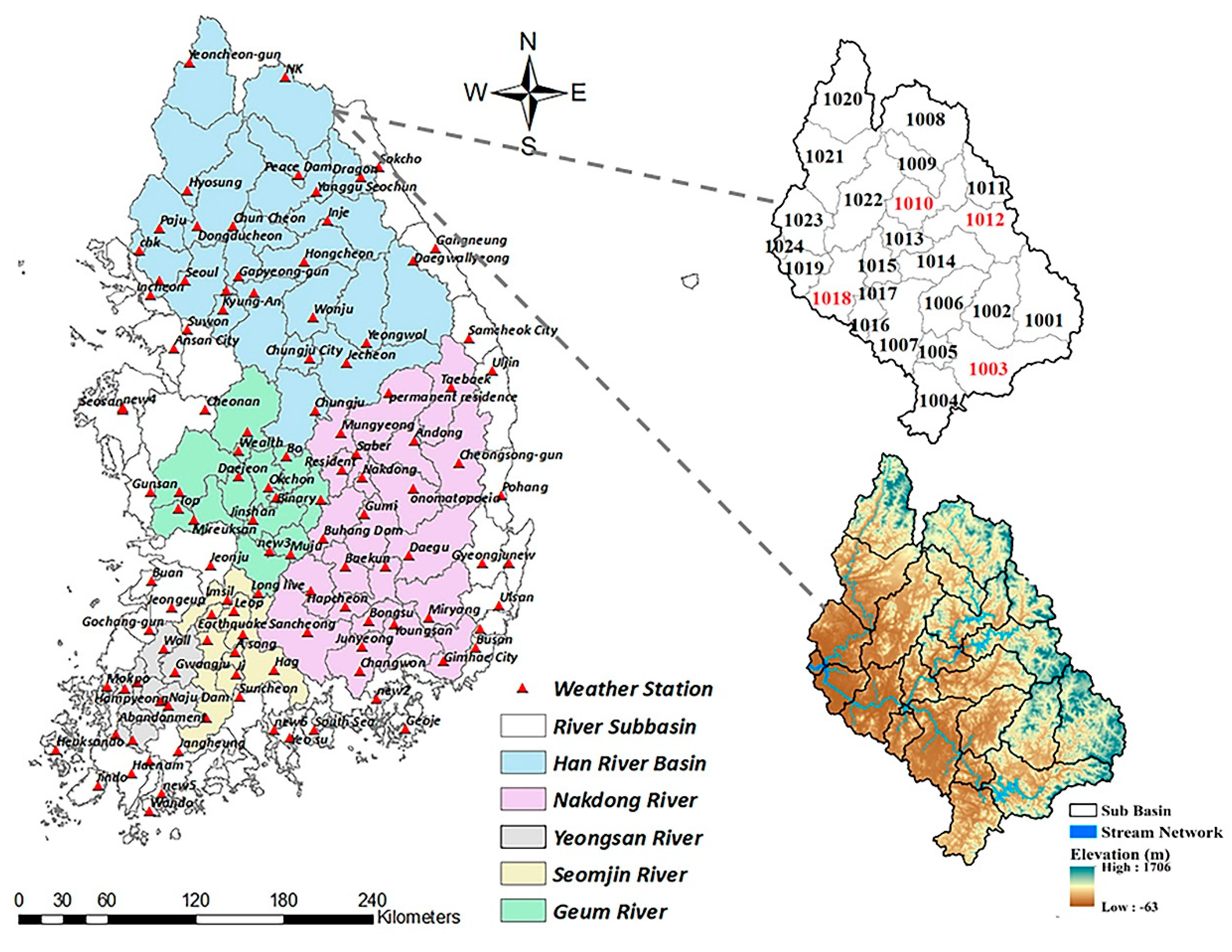
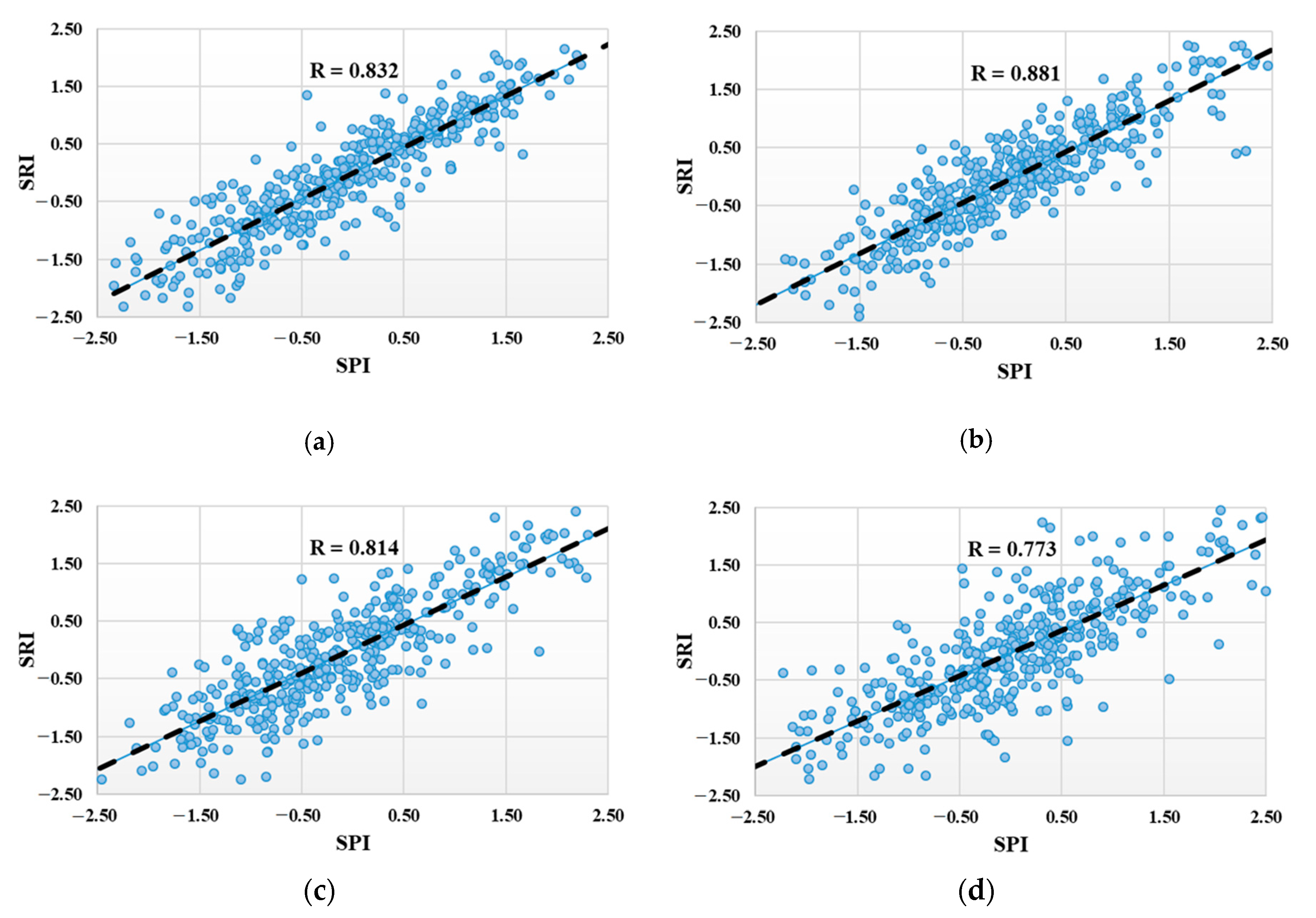
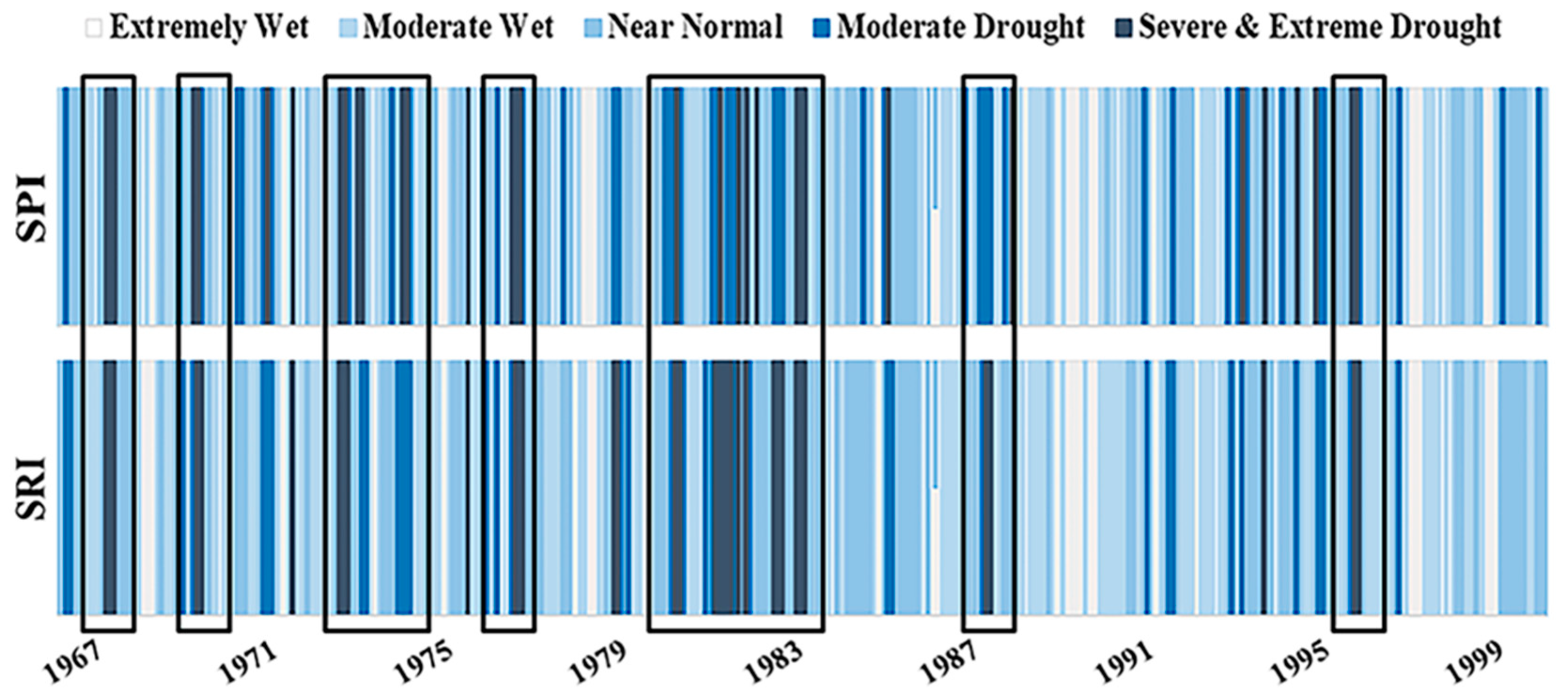
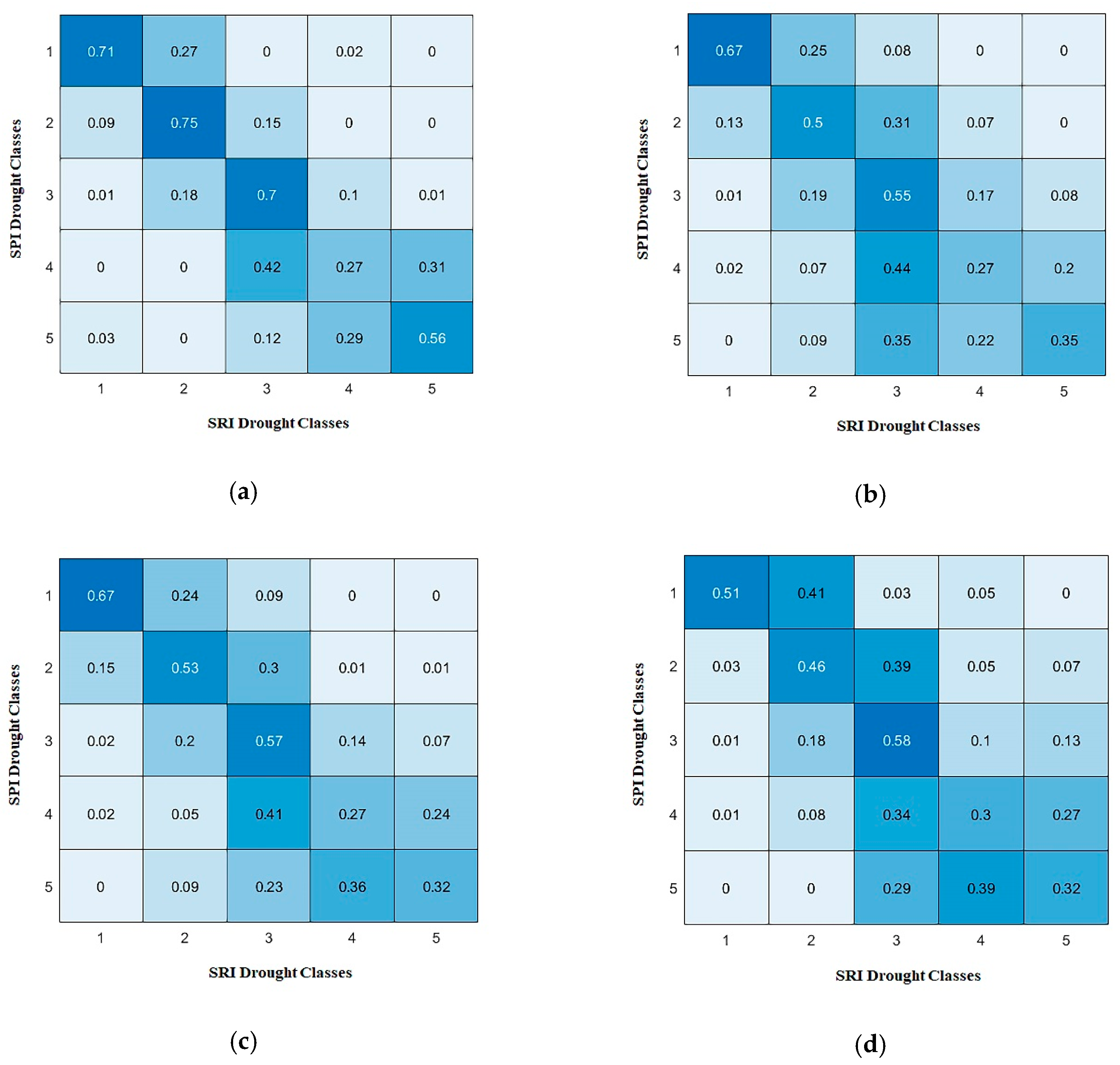
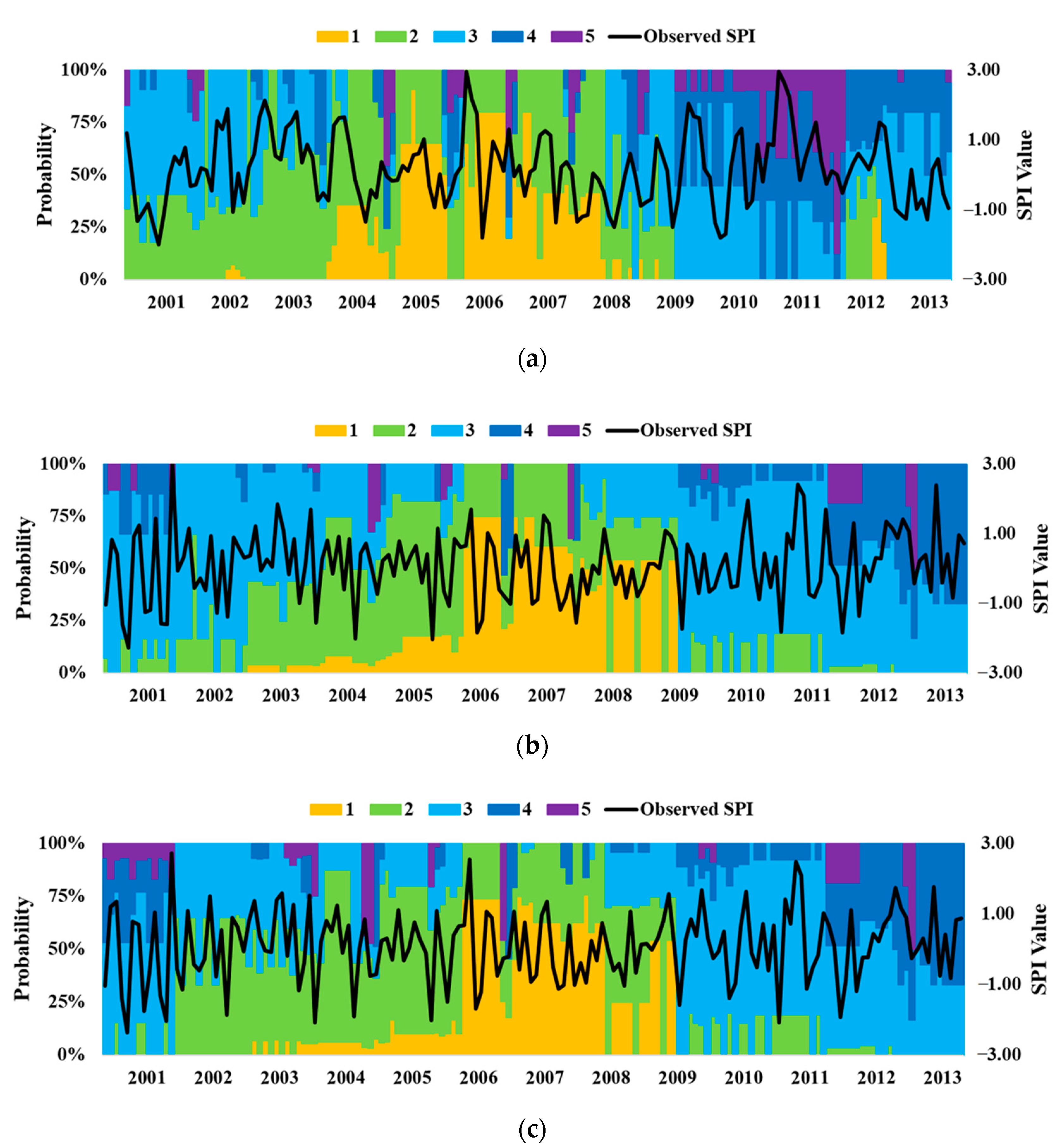
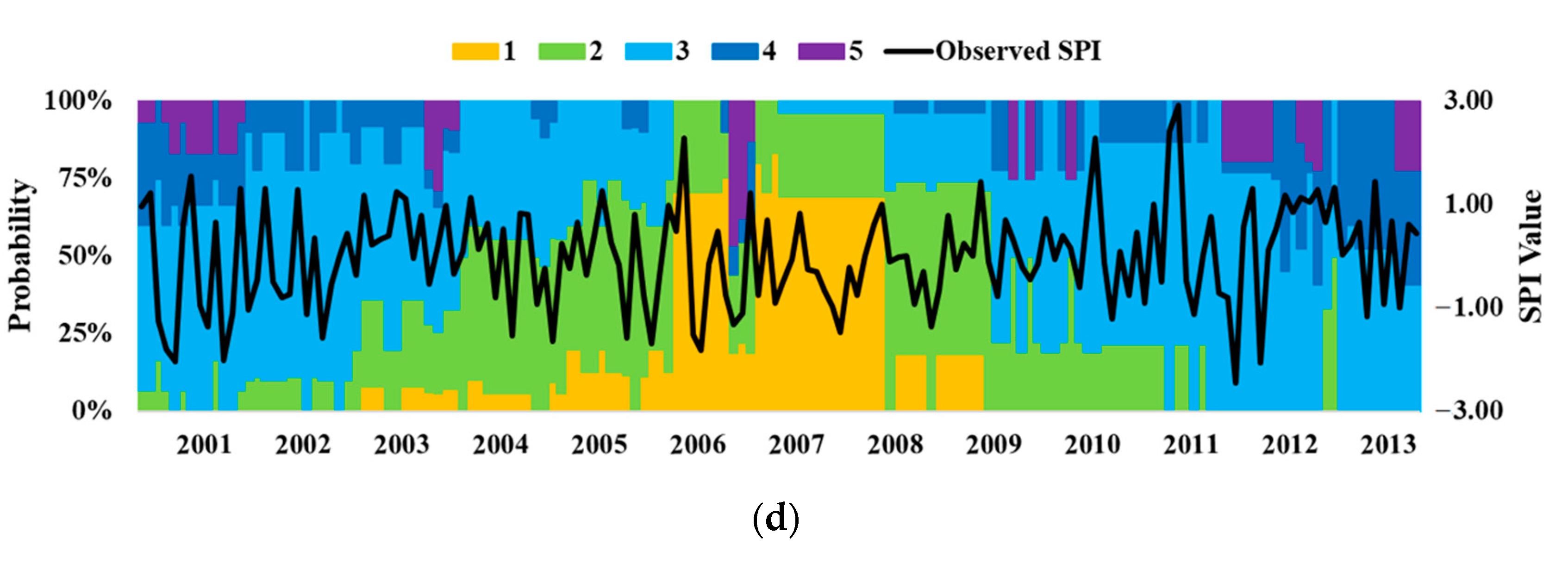
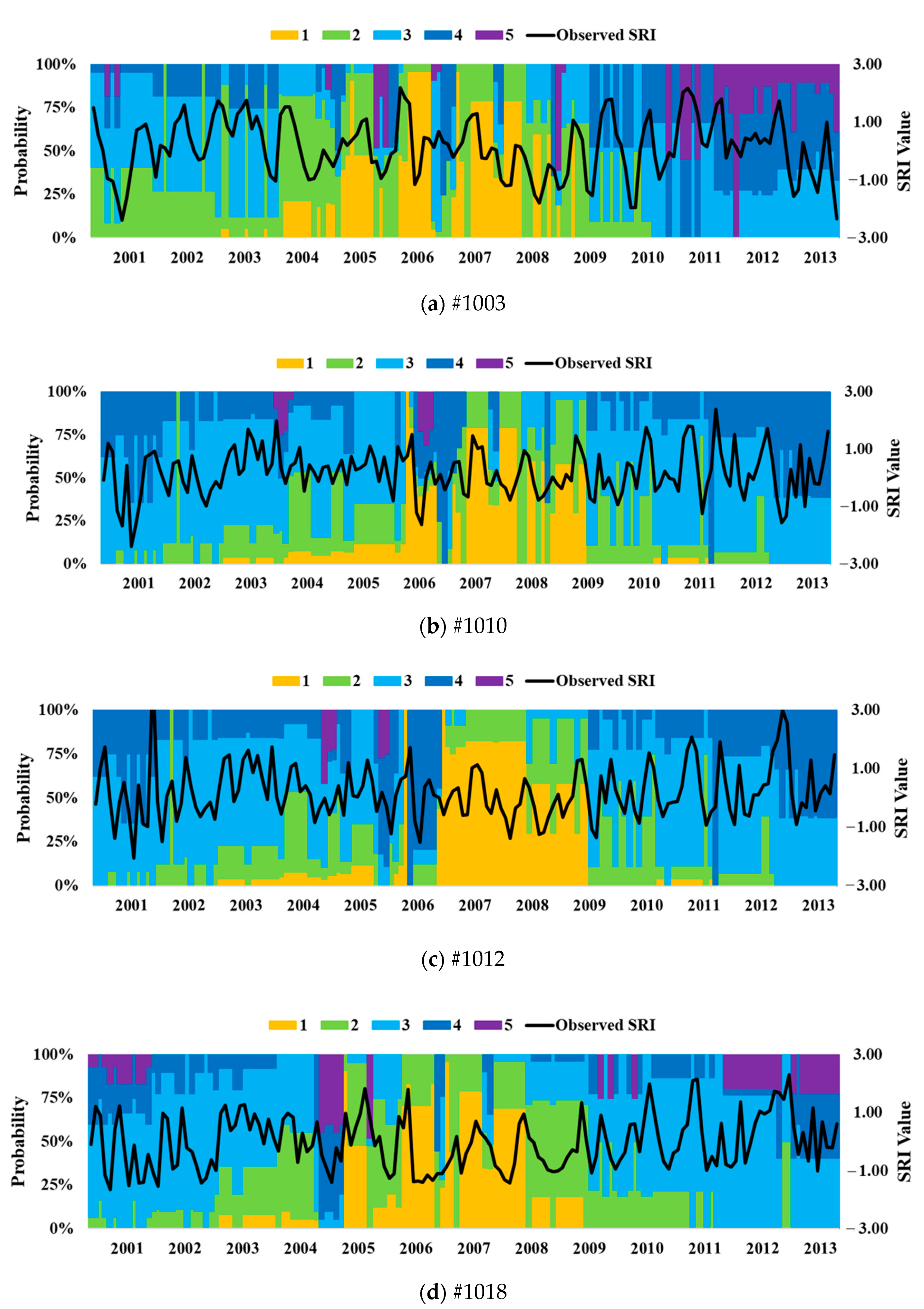
| Wet and Drought Condition | SPI and SRI | MBC |
|---|---|---|
| Extreme wet | Greater than 1 | 1 |
| Moderate wet | 0 to 1 | 2 |
| Near normal | −1 to 0 | 3 |
| Moderate drought | −1.49 to −1 | 4 |
| Severe and Extreme drought | Less than −1.49 | 5 |
| MBC-Predicted Classes | MBC-Predicted Classes | ||||||||||||
|---|---|---|---|---|---|---|---|---|---|---|---|---|---|
| SPI-Actual Classes | 1 | 2 | 3 | 4 | 5 | SRI-Actual Classes | 1 | 2 | 3 | 4 | 5 | ||
| SPI-1003 | 1 | 20 | 10 | 4 | 0 | 0 | SRI-1003 | 1 | 22 | 7 | 6 | 0 | 0 |
| 2 | 5 | 36 | 11 | 4 | 0 | 2 | 12 | 29 | 10 | 5 | 0 | ||
| 3 | 3 | 2 | 34 | 6 | 0 | 3 | 1 | 8 | 26 | 7 | 2 | ||
| 4 | 1 | 3 | 2 | 8 | 1 | 4 | 0 | 1 | 4 | 5 | 1 | ||
| 5 | 0 | 1 | 1 | 1 | 3 | 5 | 0 | 1 | 3 | 2 | 4 | ||
| SPI-1010 | 1 | 16 | 7 | 3 | 0 | 0 | SRI-1010 | 1 | 17 | 8 | 3 | 0 | 0 |
| 2 | 8 | 42 | 10 | 2 | 0 | 2 | 3 | 35 | 9 | 2 | 1 | ||
| 3 | 5 | 5 | 32 | 2 | 0 | 3 | 10 | 18 | 45 | 0 | 0 | ||
| 4 | 0 | 1 | 3 | 7 | 1 | 4 | 0 | 1 | 0 | 2 | 0 | ||
| 5 | 0 | 1 | 3 | 3 | 5 | 5 | 0 | 0 | 1 | 0 | 1 | ||
| SPI-1012 | 1 | 17 | 5 | 8 | 0 | 0 | SRI-1012 | 1 | 18 | 8 | 7 | 0 | 0 |
| 2 | 8 | 32 | 10 | 3 | 0 | 2 | 9 | 23 | 15 | 2 | 1 | ||
| 3 | 7 | 6 | 30 | 3 | 2 | 3 | 7 | 4 | 42 | 9 | 1 | ||
| 4 | 0 | 1 | 4 | 7 | 2 | 4 | 0 | 1 | 2 | 4 | 0 | ||
| 5 | 0 | 2 | 3 | 2 | 4 | 5 | 0 | 0 | 2 | 0 | 1 | ||
| SPI-1018 | 1 | 13 | 8 | 4 | 0 | 0 | SRI-1018 | 1 | 13 | 8 | 3 | 2 | 0 |
| 2 | 7 | 33 | 14 | 0 | 0 | 2 | 9 | 22 | 8 | 4 | 0 | ||
| 3 | 3 | 6 | 36 | 8 | 0 | 3 | 7 | 7 | 37 | 10 | 2 | ||
| 4 | 0 | 0 | 4 | 7 | 1 | 4 | 0 | 2 | 3 | 7 | 0 | ||
| 5 | 0 | 1 | 2 | 3 | 6 | 5 | 0 | 1 | 0 | 6 | 5 | ||
| Sub-Basin ID | Accuracy of Meteorological Drought Classes (%) | Precision of Meteorological Drought Classes (%) | ||||||||
|---|---|---|---|---|---|---|---|---|---|---|
| 1 | 2 | 3 | 4 | 5 | 1 | 2 | 3 | 4 | 5 | |
| 1003 | 59 | 64 | 76 | 53 | 50 | 69 | 69 | 65 | 42 | 75 |
| 1010 | 62 | 68 | 73 | 58 | 42 | 55 | 75 | 63 | 50 | 83 |
| 1012 | 57 | 60 | 63 | 50 | 36 | 53 | 70 | 55 | 47 | 50 |
| 1018 | 52 | 61 | 68 | 58 | 50 | 57 | 69 | 60 | 39 | 86 |
| Sub-Basin ID | Accuracy of Hydrological Drought Classes (%) | Precision of Hydrological Drought Classes (%) | ||||||||
|---|---|---|---|---|---|---|---|---|---|---|
| 1 | 2 | 3 | 4 | 5 | 1 | 2 | 3 | 4 | 5 | |
| 1003 | 63 | 52 | 59 | 45 | 40 | 58 | 85 | 46 | 26 | 50 |
| 1010 | 61 | 70 | 62 | 67 | 50 | 57 | 56 | 78 | 50 | 50 |
| 1012 | 55 | 46 | 67 | 57 | 33 | 53 | 64 | 62 | 27 | 33 |
| 1018 | 50 | 51 | 59 | 58 | 42 | 45 | 55 | 73 | 24 | 71 |
© 2020 by the authors. Licensee MDPI, Basel, Switzerland. This article is an open access article distributed under the terms and conditions of the Creative Commons Attribution (CC BY) license (http://creativecommons.org/licenses/by/4.0/).
Share and Cite
Sattar, M.N.; Jehanzaib, M.; Kim, J.E.; Kwon, H.-H.; Kim, T.-W. Application of the Hidden Markov Bayesian Classifier and Propagation Concept for Probabilistic Assessment of Meteorological and Hydrological Droughts in South Korea. Atmosphere 2020, 11, 1000. https://doi.org/10.3390/atmos11091000
Sattar MN, Jehanzaib M, Kim JE, Kwon H-H, Kim T-W. Application of the Hidden Markov Bayesian Classifier and Propagation Concept for Probabilistic Assessment of Meteorological and Hydrological Droughts in South Korea. Atmosphere. 2020; 11(9):1000. https://doi.org/10.3390/atmos11091000
Chicago/Turabian StyleSattar, Muhammad Nouman, Muhammad Jehanzaib, Ji Eun Kim, Hyun-Han Kwon, and Tae-Woong Kim. 2020. "Application of the Hidden Markov Bayesian Classifier and Propagation Concept for Probabilistic Assessment of Meteorological and Hydrological Droughts in South Korea" Atmosphere 11, no. 9: 1000. https://doi.org/10.3390/atmos11091000
APA StyleSattar, M. N., Jehanzaib, M., Kim, J. E., Kwon, H.-H., & Kim, T.-W. (2020). Application of the Hidden Markov Bayesian Classifier and Propagation Concept for Probabilistic Assessment of Meteorological and Hydrological Droughts in South Korea. Atmosphere, 11(9), 1000. https://doi.org/10.3390/atmos11091000








